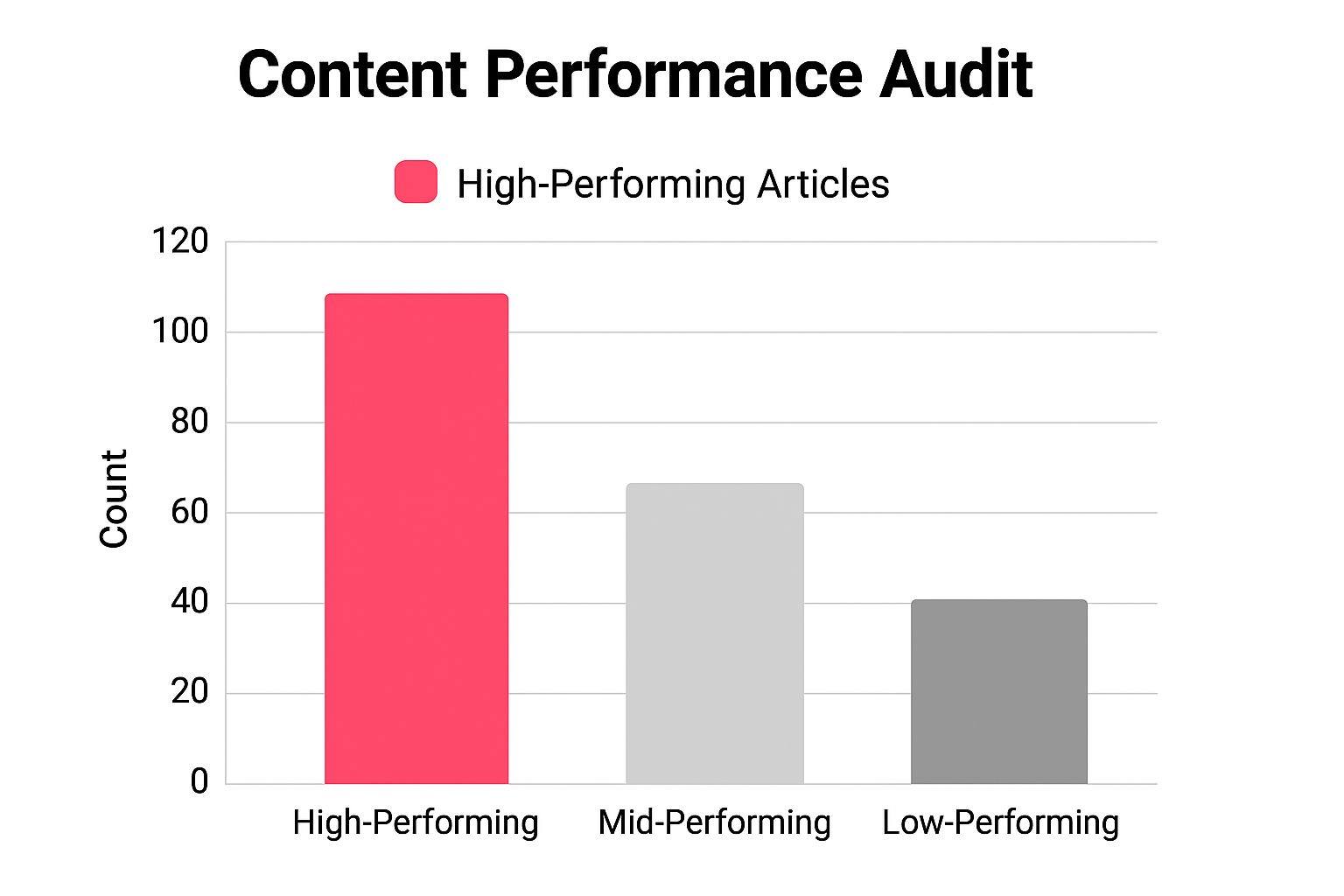 A Quick Guide to Using TikTok GMV Max to Grow Your TikTok Shop
A Quick Guide to Using TikTok GMV Max to Grow Your TikTok Shop
Table of Contents
The New Content Landscape: Why Traditional Approaches Fall Short

The current content landscape is a competitive space. Businesses are constantly fighting for audience attention in this crowded marketplace. This dynamic environment requires a significant volume of content, a demand that many organizations struggle to meet. Traditional content creation methods, often slow and demanding of resources, are becoming major obstacles.
These older approaches simply can't keep up with the ever-growing need for engaging, up-to-date content. This means companies sticking with outdated methods are at risk of getting left behind. It's a critical moment for businesses to assess their content strategies and explore new ways to connect with their audiences.
The Rise of the Creator Economy
The significant growth of the creator economy has dramatically changed what audiences expect. Consumers are now used to a steady flow of high-quality content across a variety of platforms. Platforms like TikTok and YouTube have made short-form video content the norm, influencing competitor content and forcing businesses to rethink their strategies. This presents both a hurdle and a major chance for companies wanting to produce content at scale.
The creator economy's impact on digital media and marketing is undeniable. As of early 2025, YouTube alone hosts over 64 million content creators. Since 2020, more than 165 million people worldwide have become creators on social media. What's interesting is that roughly 60% of these creators still have full-time jobs, often seeing content creation as a way to earn extra income. For more data on this, explore this topic further. This rapid growth highlights the necessity for businesses to modernize their content approaches to connect with these growing audiences.
Breaking Free From Traditional Bottlenecks
Traditional content creation often involves linear workflows, numerous approval stages, and infrequent repurposing. These factors contribute to sluggish production times and limit how much content can be created. Businesses that have figured out content scaling, however, consistently outperform those clinging to these older methods.
These successful companies understand that quick responses, flexibility, and high output are essential for success in the current environment. They are adapting to the changing demands of the content landscape and reaping the rewards.
Embracing a Scalable Mindset
Scaling content creation isn’t simply about producing more. It's about making the most of each piece of content you create. This means strategically reusing content in different formats, improving workflows, and using smart distribution techniques. Adopting new technologies and platforms, like AI-powered content creation platforms such as JoinBrands, can also dramatically improve output and speed up the process. By focusing on scalability, businesses can successfully navigate the changing content world and achieve consistent growth.
Building Your Content Production Engine That Actually Scales
Behind every successful content strategy is a robust content production engine. It's not about simply increasing resources; it's about establishing a system for creating more high-quality content without overworking your team. Think of it as an assembly line, where every part is crucial.
Identifying and Eliminating Bottlenecks
Scaling content creation starts with identifying bottlenecks—the parts of your current process causing slowdowns. These might be lengthy approval stages, unclear workflows, or a lack of standardized processes. For example, a week-long content approval process is a major bottleneck. Addressing these is like clearing a highway for smoother traffic flow.
Implementing Standardized Workflows
After pinpointing bottlenecks, establish standardized workflows. Document each step of the content creation process, from ideation to publishing. This ensures consistency, quality, and simplifies onboarding. Think of this documentation as a comprehensive instruction manual, easily understood by everyone.

This infographic illustrates data from a content performance audit, categorizing articles into performance groups. The chart reveals a substantial portion of content in the mid-performing category, indicating potential for improvement through optimized production and distribution.
Building a Scalable Content Team
Scaling also requires a skilled team: writers, editors, and content managers who understand your brand and workflows. Equipping your team with the right tools is also vital. Platforms like JoinBrands can streamline workflows, connecting you with creators and offering AI-powered tools for managing campaigns and scaling content creation. Explore our guide on How to master user-generated content for a strategic approach to team building and resource allocation.
Structuring for Success: Production Calendars and Beyond
Scaling effectively necessitates a structured approach. This includes using a detailed content calendar, outlining topics and deadlines. A defined approval process is also critical for quality control and avoiding delays. This planning helps manage large content volumes efficiently. Consistent quality control maintains high standards despite increased production.
To understand the essential components of a scalable content production system, let's examine the following table:
Content Production Framework Components
A breakdown of essential elements needed in a scalable content production system
| Framework Component | Purpose | Implementation Tips | Scaling Benefits |
|---|---|---|---|
| Standardized Workflows | Ensure consistency and efficiency in content creation | Document every step of the process, create templates, and use project management tools | Increased productivity, reduced errors, and streamlined onboarding |
| Content Calendar | Plan and schedule content in advance | Use a shared calendar, assign deadlines, and plan for different content formats | Consistent publishing schedule and better resource allocation |
| Skilled Team | Assemble a team with the necessary expertise | Hire experienced writers, editors, and content managers. Invest in training and development | High-quality content and efficient workflows |
| Appropriate Tools | Utilize software and platforms to enhance productivity | Use content management systems, collaboration platforms, and AI-powered tools | Streamlined workflows, improved collaboration, and data-driven insights |
| Defined Approval Process | Ensure quality control and avoid delays | Establish clear approval stages and timelines. Use feedback tools for efficient communication | Maintain quality standards and avoid bottlenecks |
This table highlights the key elements of a scalable content framework, from standardized workflows to the utilization of appropriate tools. Implementing these components enables efficient, high-quality content production.
The global digital content creation market is booming, projected to reach over $60 billion by 2030 and nearly $90.4 billion by 2033, with a CAGR of 12.8%. More detailed statistics are available here. This growth underscores the increasing need for effective scaling strategies.
AI Tools That Actually Deliver: Beyond the Hype

Building a robust content production engine is now simpler than ever, thanks to the proliferation of AI tools. However, distinguishing truly effective solutions from the marketing hype is crucial for successfully scaling content creation. Let's explore how AI can genuinely elevate your content production.
AI tools are changing the way we create content. For a more in-depth understanding of generative AI, a key player in this evolution, refer to this helpful definition: Generative AI. This AI type is especially valuable for brainstorming and initial drafting.
From Ideation to Optimization: Where AI Shines
AI shines in several stages of the content creation process. AI-powered tools can provide substantial assistance with tasks such as:
- Ideation: Generating topic ideas based on keyword research and current trending discussions.
- Draft Creation: Quickly producing first drafts, freeing up human writers to focus on more nuanced and complex tasks.
- Optimization: Refining content for SEO by analyzing keyword density, readability, and other critical factors.
- Content Repurposing: Adapting existing content for various formats, including social media posts or email newsletters.
This doesn't eliminate the need for human creativity; rather, it enhances it. This allows content teams to operate with greater efficiency.
Real-World Workflows: Blending AI and Human Expertise
Modern content teams are integrating AI into their workflows in practical ways. They use AI to rapidly generate multiple headline options or explore different outline variations. They're also using AI to personalize content for specific audience segments. The key, however, is maintaining human oversight. This ensures quality control and maintains a consistent brand voice. This blend of AI and human expertise results in faster turnaround times without sacrificing quality.
Avoiding Common Pitfalls: The Human Element
While AI offers numerous advantages, potential downsides require careful attention. Over-reliance on AI can produce generic content that lacks a unique brand voice. For example, depending solely on AI-generated text might not accurately reflect your brand's personality. Human review and editing are essential. Additionally, ensuring factual accuracy remains a human responsibility.
Another critical factor is the ethical use of AI in content creation. Transparency about how and when AI is used is paramount for building and maintaining audience trust. This openness promotes ethical practices and demonstrates a commitment to responsible AI implementation.
The rise of hyperscale social video platforms like YouTube and TikTok has significantly impacted how creators scale their output. By 2025, 49% of marketers globally are projected to rely on video content, highlighting its crucial role in engaging consumers. This trend requires content creators to optimize content for a variety of platforms and formats. For further insights into these evolving trends, explore the 2025 Digital Media Trends report. This growing demand necessitates smarter, AI-powered solutions for efficient content scaling.
Choosing the Right Tools: Practical Considerations
Selecting the right AI tools requires careful evaluation. Key factors to consider include:
- Ease of integration with current workflows.
- Specific features aligned with your content needs (e.g., SEO optimization, language translation).
- Pricing models that fit within your budget.
By carefully considering these aspects, you can choose tools that effectively enhance your team's capabilities. Platforms like JoinBrands, which offer AI-powered creator matching and streamlined campaign management tools, offer a viable solution for scaling content creation without sacrificing quality or brand authenticity. Through proper implementation and a balanced approach, businesses can leverage AI tools to achieve new levels of content creation efficiency.
Content Multiplication: Get 5x Results From Every Asset
Creating a lot of content is great, but are you getting the most out of it? Smart content teams know the secret: repurposing. It's about taking one piece of content and transforming it to work across multiple platforms. This expands your reach without requiring a massive increase in budget or time.
Mapping Out Content Transformations
Think about repurposing before you even start creating. Ask yourself, "Could this blog post become an infographic? Could this webinar be chopped into short social media videos?" This forward-thinking approach is key to efficiency. Planning ahead ensures your content is modular, making future transformations a breeze.
Identifying High-Potential Pieces
Let's be honest, not all content is a superstar. Some pieces naturally have more repurposing potential. How do you find them? Analyze your data. Look for content that's already resonating with your audience – the stuff that drives traffic and sparks discussions. For example, a popular blog post could easily become a downloadable guide or a series of engaging social media posts.
Building a System for Repurposing
Repurposing shouldn't be a random act. Integrate it into your workflow. Create a system – maybe a dedicated repurposing content calendar, regular brainstorming sessions, or even standardized templates for different formats. Tools like Smartstudi's paraphrase feature can also help create variations quickly: paraphrase content. This structured approach will boost your output significantly.
Format-Specific Adaptations: Maintaining Message Integrity
Repurposing isn't just copy-pasting. Each platform has its own nuances. A tweet is very different from a LinkedIn article. You might need to tweak the tone, add visuals, or adjust the length. The key is to optimize for each channel while keeping your core message consistent and maintaining the value of the original content.
The Repurposing Efficiency Matrix
The table below illustrates the power of repurposing. It shows how a single asset can be transformed into multiple formats, each with varying resource needs and reach potential.
To illustrate the potential benefits, let's look at the efficiencies you can gain from repurposing. The following table provides a comparison.
Content Repurposing Efficiency Matrix
Comparison of different content formats and their repurposing potential
| Original Format | Derivative Formats | Resource Requirements | Time Efficiency | Audience Reach Potential |
|---|---|---|---|---|
| Blog Post | Social Media Updates, Infographic, Email Newsletter, Short Video | Low | High | Medium to High |
| Webinar | Short Videos, Blog Post Series, Podcast Episodes | Medium | Medium | Medium |
| Infographic | Social Media Graphics, Presentation Slides, Website Banners | Low | High | Medium |
| Podcast Episode | Blog Post, Social Media Quotes, Short Audio Clips | Low | High | Medium |
| Video | Short Clips for Social Media, Blog Post Summary, Podcast Episode | Medium | Medium | High |
As you can see, a single blog post can become several different pieces of content, each reaching a different segment of your audience. Strategic repurposing maximizes your impact without dramatically increasing your workload. You're essentially getting more mileage out of everything you create. This is a powerful way to scale your content creation efforts and maximize your reach.
Building Your Dream Team: The People Behind Scale

Scaling content creation depends significantly on the people executing the strategies. Even with the most efficient systems, a skilled team is essential for success. This means recruiting, training, and managing individuals who excel in a fast-paced, high-volume environment. This section explores how to build a team capable of scaling content creation effectively.
Identifying Key Roles and Skills
First, pinpoint the essential roles within your content team. These typically include writers, editors, content strategists, SEO specialists, and project managers. Each role requires a distinct skill set. Writers need adaptable writing skills across various formats. Editors need impeccable grammar and attention to detail.
Content strategists need to understand the target audience and develop a comprehensive content plan. They might, for instance, analyze audience data to find trending topics and areas where content is lacking. SEO specialists will work to ensure content is optimized for search engines. Finally, project managers will oversee workflows and deadlines.
Building Your Team: In-House, Freelance, or Agency?
You can build your content team in several ways. Creating an in-house team gives greater control and strengthens brand consistency, but it can be expensive. Using freelancers offers flexibility and access to specialized skills, but managing numerous freelancers can be difficult. Partnering with a content marketing agency offers expertise and streamlined workflows, but often at a higher cost. For advice on building successful partnerships, check out this guide on How to master influencer relationship management.
Onboarding and Training: Setting Your Team Up for Success
Effective onboarding and training are essential for new team members. Provide clear documentation on content strategy, style guides, and workflows. A style guide, for example, ensures consistent brand voice and messaging. Regular training keeps the team updated on best practices and new tools like Semrush for SEO. This maintains quality and efficiency as your team scales.
Structuring Your Team for Scale
As your content operation grows, team structure becomes increasingly important. Consider organizing your team by content type (blog posts, video, social media), target audience, or project. This allows for specialization and streamlined workflow management. A dedicated social media team, for example, can focus on creating engaging content specifically for those platforms.
Fostering Communication and Collaboration
Open communication and collaboration are essential. Implement tools and processes for seamless communication, such as Asana for project management, shared content calendars, and regular team meetings. These practices ensure everyone stays aligned and informed.
Managing and Motivating Your Team
Effective management keeps your team motivated and productive. Provide regular feedback, acknowledge accomplishments, and foster a positive work environment. Offer opportunities for professional development to keep your team engaged and invested in their growth. This continuous improvement is crucial for maintaining high performance.
Feedback Mechanisms: Continuous Improvement
Establish regular feedback mechanisms to identify areas for improvement. This might include one-on-one meetings, team surveys, or performance reviews. This feedback loop allows you to address issues quickly and refine processes. This proactive approach helps avoid bottlenecks and ensures smooth scaling. For additional insights into managing your content team, see How to scale content creation. A successful scaling strategy ultimately depends on a well-structured and supported team. Platforms like JoinBrands can help streamline this process with AI-powered creator matching and campaign management tools.
Distribution at Scale: Ensuring Your Content Actually Performs
Creating tons of content is pointless if it doesn't reach the right audience. This section explores how to effectively distribute your content at scale, ensuring it resonates and drives results. This means understanding platform optimization, creating promotional workflows, and constantly refining your approach.
Platform-Specific Optimization: Tailoring Your Content
Different platforms demand different approaches. What thrives on LinkedIn might flop on TikTok. Developing platform-specific optimization systems is crucial. This doesn't mean starting from scratch for every channel. Instead, identify core elements you can adapt.
For example, a blog post can become a series of tweets, a LinkedIn article with a fresh perspective, and even short, engaging videos for Instagram and TikTok. This maximizes reach with a consistent message. Understanding each platform's nuances is key.
Building Promotional Workflows: Amplifying Your Reach
Even great content needs a boost. Building promotional workflows that maximize initial impact is essential. This includes using social media, email marketing, and paid advertising. Think of it as a launch sequence, propelling your content into the world.
- Social Media Promotion: Share your content across relevant platforms, tailoring your message for each audience.
- Email Marketing: Notify your subscribers of new content, emphasizing its value. You might be interested in: How to master influencer marketing best practices.
- Paid Advertising: Use platforms like Google Ads or social media ads to target specific demographics.
These coordinated efforts amplify your reach and ensure your content finds the right people.
Testing and Iteration: Continuous Improvement
Distribution, like content creation, is ongoing. Implementing testing frameworks for constant improvement is crucial. This means tracking metrics like click-through rates, engagement, and conversions.
Analyzing this data reveals what's working. This could involve A/B testing headlines, trying various content formats, or adjusting promotional strategies. The key is constant refinement based on data.
Audience-Specific Distribution: Reaching the Right People
Understanding your audience is paramount. Successful brands develop audience-specific distribution plans. This involves segmenting your audience by demographics, interests, and online behavior.
Tailoring your distribution strategy to each segment ensures your content resonates and drives meaningful engagement. This personalized approach builds deeper connections and boosts conversion potential.
Organic vs. Paid: A Complementary Approach
Organic and paid distribution are vital in a successful content strategy. Top brands leverage both in complementary ways. Organic reach builds long-term trust and authority, while paid promotion reaches new audiences.
Finding the right balance is key for maximizing impact. This might involve using organic social media for community building and paid ads to target specific demographics for lead generation.
Data-Driven Refinement: Real-Time Optimization
Successful content operations use performance data to refine content creation and distribution strategies in real-time. This feedback loop ensures constant learning and improvement.
By analyzing data and adapting, you can create a content engine that delivers consistent results. Platforms like JoinBrands offer the tools to manage these complex processes, connecting you with creators and providing AI-powered solutions for streamlining your efforts. This data-driven approach is the cornerstone of successful content scaling.
Measuring What Matters: Performance Metrics That Drive Decisions
As your content operation grows, your measurement strategies need to grow with it. Simply looking at vanity metrics like page views isn't enough. You need to zero in on the key performance indicators (KPIs) that have a direct impact on your business goals and shape your strategic decisions. This section explores how data-driven content teams leverage performance metrics to refine their scaling strategy.
Implementing Measurement Frameworks: Balancing Comprehensiveness and Clarity
Building the right measurement framework is crucial; it's the foundation upon which your content strategy stands. This framework needs to provide a complete picture of your content's performance while delivering clear, actionable information. Don't get lost in a sea of data. Focus on the metrics that truly align with your business objectives.
For example, if lead generation is your primary goal, prioritize metrics like conversion rates and cost per lead. If you're focused on building brand awareness, track metrics like reach, social shares, and brand mentions. A well-defined framework keeps you focused on what truly matters.
Developing Actionable Dashboards: Highlighting Key Insights
Your content performance dashboard should provide at-a-glance access to the most critical information. Avoid cluttered dashboards overflowing with data. Instead, focus on the KPIs that actually drive your decision-making process.
Organize your dashboard around your core business objectives. This allows you to quickly identify what's working and what needs to be adjusted. For example, if a particular content format isn't performing well, you can quickly pinpoint the issue and take corrective action.
Establishing Feedback Loops: Continuous Improvement
Scaling content creation is an ongoing process. Establishing feedback loops is essential for continuous learning and improvement. Regularly review your performance data, identify trends, and adjust your strategy accordingly. These adjustments can be minor tweaks to your promotion strategy or major shifts in content format. Constant iteration is the key to sustained success.
For instance, if long-form blog posts generate more leads than short videos, you might prioritize blog content. If a specific distribution channel underperforms, you can refine your approach or explore other channels.
Attributing Revenue Impact: Connecting Content to Business Outcomes
Showing the impact of content on revenue can be a challenge. As you scale, attributing revenue to specific content initiatives becomes even more important. This justifies your investment and demonstrates the value of your content marketing efforts.
Several methods can help attribute revenue. These include tracking conversions from specific content, using UTM parameters to monitor campaign performance, and analyzing customer journeys. This data offers valuable insights for future planning and budget allocation.
Measuring Audience Growth and Engagement
While revenue is a critical metric, don't neglect audience growth and engagement. These metrics provide valuable insights into your content's effectiveness and how well it resonates with your target audience. Track metrics like follower growth, social shares, comments, and time spent on page.
High engagement rates, for example, show that your content is grabbing attention. This information helps you identify successful content formats and topics, enabling you to replicate that success in future campaigns.
Competitive Analysis: Identifying Strategic Opportunities
As your content operation scales, monitoring your competitors is crucial. Competitive analysis reveals valuable insights into their strategies, uncovering potential opportunities and market gaps. This helps you refine your approach, differentiate your content, and stay ahead of the competition.
Analyze the type of content your competitors produce, the platforms they use, and their promotion strategies. This allows you to identify areas where you can excel and capitalize on untapped opportunities. This competitive intelligence strengthens your strategy and positions your brand for success.
Scale your content creation and maximize your impact with JoinBrands. Our platform offers the tools and resources you need to streamline your workflows, connect with creators, and achieve measurable results. Learn more about how JoinBrands can help you scale your content creation.








